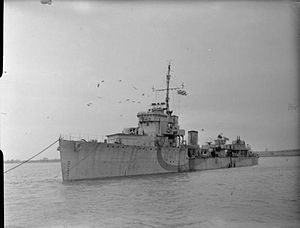HMS Whitshed (D77)

Whitshed during World War II
|
|
| History | |
|---|---|
| Name: | HMS Whitshed |
| Ordered: | April 1918 |
| Laid down: | June 1918 |
| Launched: | 31 January 1919 |
| Commissioned: | 11 July 1919 |
| Refit: | Rebuilt as a short range escort (SRE) 1940 |
| Struck: | Sold to BISCO for scrapping February 1947 |
| Motto: |
|
| Honours and awards: |
|
| Fate: | Scrapped April 1948 |
| Badge: | On a Field Red, a Demi-Lion rampant Gold, holding a trefoil Green. |
| General characteristics | |
| Class and type: | Admiralty modified W-class destroyer |
| Displacement: | 1,140 tons standard, 1,550 tons full |
| Length: | 300 ft o/a, 312 ft p/p |
| Beam: | 29.5 feet (9.0 m) |
| Draught: | 9 feet (2.7 m), 11.25 feet (3.43 m) under full load |
| Propulsion: | Yarrow type Water-tube boilers, Brown-Curtis geared steam turbines, 2 shafts, 27,000 shp |
| Speed: | 34 kt |
| Range: |
|
| Complement: | 127 |
| Sensors and processing systems: |
|
| Armament: |
|
| Service record | |
| Operations: | |
| Victories: | U-55 |
HMS Whitshed (D77/I77) was an Admiralty modified W-class destroyer of the Royal Navy. She was ordered from Swan Hunter & Wigham Richardson Ltd under the 14th Order for Destroyers in the Emergency War Program of 1918–19. She was the first ship to carry the name.
HMS Whitshed's keel was laid on 3 June 1918 at the Swan Hunter & Wigham Richardson Ltd. at Wallsend on Tyne. She was launched on 31 January 1919. She was 312 feet (95 m) overall in length with a beam of 29.5 feet (9.0 m). Her mean draught was 9 feet (2.7 m), and would reach 11.25 feet (3.43 m) under full load. She had a displacement of 1,140 tons standard and up to 1,550 full load.
She was propelled by three Yarrow water tube boilers powering Brown-Curtis geared steam turbines developing 27,000 SHP driving two screws for a maximum designed speed of 34 knots. She was oil-fired and had a bunkerage of 320 to 370 tons. This gave a range of between 3500 nautical miles at 15 knots and 900 nautical miles at 32 knots.
She shipped four BL 4.7 in (120-mm) Mk.I guns, mount P Mk.I naval guns in four single centre-line turrets. The turrets were disposed as two forward and two aft in super imposed firing positions. She also carried two QF 2 pdr Mk.II "pom-pom" (40 mm L/39) mounted abeam between funnels. Abaft of the second funnel, she carried six 21-inch Torpedo Tubes in triple mounts on the centre-line.
HMS Whitshed was commissioned on 11 July 1919 into the Royal Navy with pennant number FA7. She was assigned to the 3rd Destroyer Flotilla in the Atlantic Fleet. In October 1919 she was assigned the pennant number D77 under a simplification of the pennant number system. The Flotilla served in Home waters in the early 1920s. The Flotilla was first assigned to the Mediterranean and in 1926 to the China Station. She was involved in the Nanking Incident in March 1927. When the United States Navy gunboat USS Fulton was heavily damaged by fire while at sea off China on 14 March 1934, Whitshed, her sister ship HMS Wishart, and the merchant ship SS Tsinan came to Fulton's assistance. Wishart and Tsinan took off Fulton's crew, three of whom had suffered minor injuries, and took them to the Royal Navy Dockyard at Hong Kong while Whitshed stood by Fulton until a salvage party could put the fire out. The United States Department of the Navy later passed thanks to British naval authorities for the assistance Wishart and Whitshed provided to Fulton and her crew.
...
Wikipedia
